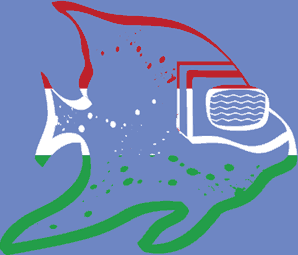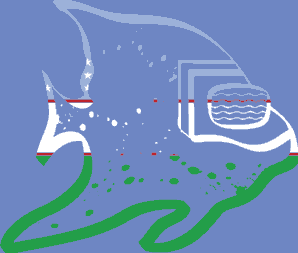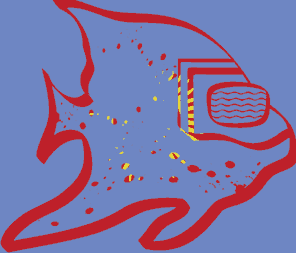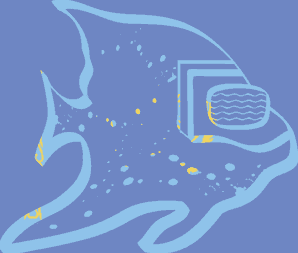 Tajikistan
Tajikistan 1. The Voice Of the Eternity,
2004. 8 min.
1. The Voice Of the Eternity,
2004. 8 min. The author tells about the Hazrati Mavlono Mausoleum in
Tajikistan and about how utter strangers and pilgrims become close and open
to each other when they get into another dimension.
 2.
What is Buddha Dreaming Of?, 2004. 6 min. 40 sec.
2.
What is Buddha Dreaming Of?, 2004. 6 min. 40 sec.The work tells about the giant statue of Buddha, found
during excavations in Ajina Tepe (7th century), which is now kept in the
Tajikistan National Antiquity Museum. The author tries to underline the idea
of tolerance: the Tajik, mostly Moslems, respect traditions and arts of their
ancestors, as well as the confession, which is now alien to them.
 3.
The Flowers of Evil, or About Everlasting Wandering And Loneliness, 2004.
15 min.
3.
The Flowers of Evil, or About Everlasting Wandering And Loneliness, 2004.
15 min. The film is about problems of the young people in the
Tajikistan capital.
 4. The
Neon Dream, 2004. 6 min. 45 sec.
4. The
Neon Dream, 2004. 6 min. 45 sec. Nirvana, wanted by a modern human being, who is tired
out of stresses, dissatisfaction, and social and political problems of the
edge of the centuries, and who just wants to be himself at least for a minute,
is as illusory as a dream.
 Uzbekistan
Uzbekistan 5.
Earthenware Fishes, 2004. 10 min. 37 sec.
5.
Earthenware Fishes, 2004. 10 min. 37 sec. The artist is interested in the rites related
to the cult of Saint Sultan Vais with the focus of pilgrims' attention
being the sacred basin with holy fishes. The film was shot in the Xorazm
region around the ancient Khiva, at the sanctuary mazars Sultan Bobo and
Sultan Vais, near the burial vault Chinar Bobo and an old cemetery. The turning
of earthenware fishes into living creatures is like the infinite pulse of
the animate nature.
6. Corner, 2004. 9 min. 13 sec.
Sacred locations, which always attract a
human being, seem to underline the interdependence of the mental search and
existence in the reality filled with sharp edges of incomprehension. In other
words, the film is about the problem of relevance and attention to the individual
and to the society on the whole.
 7. The
Interval of Coincidences, 2004. 12 min.
7. The
Interval of Coincidences, 2004. 12 min. The film is about the author's impression of visiting
the sacred Suleiman Mount near Osh in Kyrgyzstan.
 8. Fish,
2004. 4 min.
8. Fish,
2004. 4 min. The water and the fish as its symbol are of special value
in the dry and hot climate of Central Asia. The fishes are a living embodiment
of the sacral idea of a spring, a waterfall, a brook, or a mountain river
not just in a steppe or a desert, but also in a city.
9. Shaman, 2004. 3 min.
Movements of an ordinary man melting bitumen to make a
roof create an image of a modern urban shaman worshiping the fire to the
sounds of drums.
 10. A
Territory Of the Untouchables, 2004. 9 min.
10. A
Territory Of the Untouchables, 2004. 9 min. The ground for the film was a story of an artist and a
place he had created for himself and, as it turned out later, for other people
as well, because he was representing everyone in his territory. It means
that everyone who is going to accept this space can become "untouchable"…
 11. The
Rise, 2004. 11 min. 16 sec.
11. The
Rise, 2004. 11 min. 16 sec. The film is about overcoming everlasting difficulty of
rising upward to the personal perfection and to the unity with the absolute,
if there is an understanding that the absolute does exist. When a human being
reaches the height as was determined by his fate, when the necessity of the
further spiritual and physical rise cease, he needs to rise again, may be
just virtually, analysing his way and the mistakes he made and, basically,
reliving all his life.
12. The Whirligig, 2004. 10 min.
The life of a human being, geared by the Most High, lasts
in whirling of the changing moments until the winding mechanism stops. The
variety of time and space (the background for the action are steppes, mountains,
and old streets of Bukhara and Samarkand) uncovers the dualism of the eternity
and life instants).
 Kyrgyzstan
Kyrgyzstan
 13. A
Boat Goes, 2004. 4 min.
13. A
Boat Goes, 2004. 4 min. A game, started as a trivia, turns into a gesture of respect
to austere and clear Baikal Lake.
14. Canonizaton, 2004. 5 min.
The most part of historical and memorial places in Bishkek
was created in the middle of the last century. A monument to Zhoomart Bokonbaev
(1910<0x2013>1944), a poet, playwright, and front-line soldier, was set up
in 1946 at the intersection of Dzerzhinsky Boulevard and Bokonbaev Street
by sculptor O. Manuilova, who had been studying in the Stroganov school together
with Mayakovsky. The bronze sculpture mysteriously disappeared at the end
of the last century when non-ferrous metals were massively exported from
the country. The bust have not been found as it was, most probably, melted
and sold to China. Thus, this memorial place has found its contradictory,
harsh and not a made-up story, and we are now observing origination of an
object, which bears the sacral signs. The government today is busy with reshaping
the history by creating new monumental symbols. The authors of the film have
redoubled the process of inventing new mythology. So a namesake of the hero,
an artist Gamal Bokonbaev, has decided to stand for a while on the vacant
base. This anecdote has been already fixed in the conscience of townsfolk:
the sacralisation of a location from where the monument had been stolen is
being continued.
15. Paris, 2004. 15 min.
 A
man, by virtue of certain circumstances, often creates his own sacral places
and becomes their integral part. A landscape remains, whereas men come and
go. A caravanserai on the Bishkek<0x2013>Osh route has a popular name Paris.
People with their own rules and customs reach from the dark mountain road
to the light, where they can find everything a traveller needs. Other people
serve them and work day and night to provide their guests with everything
they need. The fidgety and illuminated caravanserai has become for wayfarers
the centre of civilization, which is associated in unspoiled minds of our
people with the capital of France.
A
man, by virtue of certain circumstances, often creates his own sacral places
and becomes their integral part. A landscape remains, whereas men come and
go. A caravanserai on the Bishkek<0x2013>Osh route has a popular name Paris.
People with their own rules and customs reach from the dark mountain road
to the light, where they can find everything a traveller needs. Other people
serve them and work day and night to provide their guests with everything
they need. The fidgety and illuminated caravanserai has become for wayfarers
the centre of civilization, which is associated in unspoiled minds of our
people with the capital of France.  16.
Sacrifice, 2004. 9 min.
16.
Sacrifice, 2004. 9 min. Sacrificing animals was always tied to religious rites,
many of which were preserved till our days, though changed and simplified.
This happens primarily in cities, which don't provide spaces to perform
a ritual in detail. In Bishkek suburbs, there is a place where young people
specializing in cutting carcass come forward to buyers who choose meat for
their family and ritual fests. The author is interested in both the fact
of such a service and the place where it is offered.
 17. Searching
For the Sacral, 2004. 15 min.
17. Searching
For the Sacral, 2004. 15 min. During all his life, a man builds his environment, not
perfectly ideal, but important and filled with dear and memorable places.
There are places, which are honoured by various ethnic and religious groups.
Having become sacral, a place undergoes modifications in both space and time
and turns out to be a witness of many events in the history of the mankind.
It never looses its importance for those living today and tomorrow. However,
while honouring sacred things, a man keeps searching and trying to leave
his footprint on the earth, which is his home, actually. The film was shot
at the Issyk Ata, Kegetti, Barskoon, Boom, Ak Suu, Karakol, Issyk Ata Tuyuk
ravines, Zheti Oguz, at the Issyk Kul Lake, and the Buran Museum.
 18.
Sham, 2004. 3 min. 40 sec.
18.
Sham, 2004. 3 min. 40 sec. Kochkor valley is an ancient sacred place in Kyrgyzstan
inhabited by the spirit of Kochkor Ata, an elder in white clothes, who hides
small horns under a cap. This natural rock wall is a place of worship of
those diseased, wretched, and confused, as well as of childless women. Shamans,
byubyu, bakhshy, and emchi-demchi perform their rituals here on Thursday
nights. This is a place where ancient paganism and Moslem traditions concrete.
 19. Screwed
Towers, 2004. 9 min.26 sec.
19. Screwed
Towers, 2004. 9 min.26 sec. Duplicates of the Eiffel tower in Central Asian capitals
were erected under promotional campaigns of shops equating their services
to the European ones (at least!). However, these constructions are objects
of sightseeing by mainly Philistines who would hardly ever achieve their
dreams of visiting Paris. And what about those who are not obsessed with
this idèe fixe? What are thoughts of an artist who are passing by
these monuments to the bad taste, which have become sacral perforce? Why
do we need this false Europe and how we can fight against it? Maybe, we should
just pay no attention, bury ourselves in everyday problems and then, like
a rural tourist, take a keepsake picture in this quasi-Paris part of a city
while saying ourselves again and again that the time will come and we will
be there.
 Kazakhstan
Kazakhstan
 20.
Steppenbaroque, 2003. 15 min.
20.
Steppenbaroque, 2003. 15 min. The materials for this work are a human body and landscapes.
The icon-like portraits of naked women, the number of which grows from time
to time, are shown against a background of Kazakh graves called mazars, which
remind of a phantasmal ancient city. Mazars had their specific functions
in the steppe as they served as a refuge for late wayfarers.
21. Jihad, 2004. 4 min.
Jihad refers primarily to the inner struggle of being
a person of virtue, in order to place ourselves in "the arms of the
wind".
22. Hunting for Sheeps, 2004. 20 min.
A ram is a totem animal of nomads. People walking up the
road talk to severed ram heads and kick them, sing and finally "turn" into
rams themselves. This is what is happening to us now in our reality.
 23.
The Pit, 2004. 6 min.24 sec.
23.
The Pit, 2004. 6 min.24 sec. When considering their native locus Rudny, the authors
conclude that the culture and mythology of the city are completely based
on the Sokolovsko-Sarbaisky mining association, which is located there. The
association consists of many enterprises, which produce and treat iron ore,
including a subsurface mine, some factories, and quarries. The most known
of the latter is a huge Sarbaisky quarry that is a world known iron ore producer.
The citizens call it lovingly the "Pit". The Pit produces loadstone
(a complex oxide of ferrous and ferric iron related to spinels (ferrospinel),
which is one of the main iron ores). As is proved by its name (Rudny means "of
ore" in Russian), the city is a community of miners who serve the
Pit, and the Sokolovsko-Sarbaisky association is its core. If the Pit succeeds
in its vital activities, all townspeople do in theirs. The mother Pit provides
with work, i.e. with food and roof, with money to the municipal and national
budget, and grants a special mining identity and proud of communicating with
the mighty deity. About ten years ago, when there were a lot of rumours about
closing the Pit, many townspeople suffered from depression and apocalyptic
moods. Local telecasts and press were praising the "beauty and grandeur" of
the Pit, the grand Sarbaisky mine. Thus, the Pit is undoubtedly a sacral
object of this geographical locus (the Sun of Rudny). Moreover, each townsman,
irrespective of whether he is marked by the Pit sign or not, bears a small
part of its power and energy. The Pit enlightens, inspires, and gives magic
power. This is illustrated in the final shots: the enlightenment (one of
those enlightened is a magnetic man, a personification of magnet), and telekinesis
zapping. And there rises a question about the deity nature. What is hidden
there, in the ground? What have we dug out? Where are we going? What is that
a man reaches when digging too deep? The authors leave these questions rhetorical.
24. The Brightest City, 2004. 2 min. 18 sec.
From its very foundation in 1957, Rudny was almost deprived
of eidosphere: grey bricks of the Khrushchev and Brezhnev five-store houses,
grey chappy asphalt, grey monuments symbolising the hard work of miners.
In the last two or three months, the city has changed beyond recognition
because of the forthcoming fiftieth anniversary of the main city enterprise,
the Sokolovsko-Sarbaisky mining association. The city is now painted in bright
and joyful colours with the main changes made to the arterial road of the
city, Lenin Street, which is almost mystically connected to the Lenin Street
group that shot the film right there. The new colours of Rudny are predominantly
the state blue and yellow, and it can be said that the city resembles now
a post-modern Temple of the Sky and the Sun. However, the townsfolk who look
everyday at yellow-and-blue benches, columns, fences, litterbins, and sewer
hatches, feel themselves to be in an unreal sacral area. They try to preserve
clearness and brightness of their city and become like the Temple acolytes.
Their marches in coloured streets remind of mysterious ceremonies. They should
not worry as they have the Sky and the Sun underfoot.
 25.
Noah's Ark (from series "Chingizkhan Dream"), 2004.
30 min.
25.
Noah's Ark (from series "Chingizkhan Dream"), 2004.
30 min. Southern Kazakhstan is filled with mythology. A local
legend tells that the Noah's Ark had pulled up in the Kazgurt Mountains.
Not far from Kazgurt there is an ancient city Sairam, which preserves mausoleums
of many local saints. The Silk Way has been crossing this place. The 20th
century contributed its mite to mythologisation of the region. In Shymkent,
there are monuments to the Red Tractor and to the fighting machine; in the
children's park there is a monument to the military helicopter, which
has been reequipped to become a caf<0x00E9>. The pipes of an oil refinery,
and tyre, lead, and phosphorous plants, which pollute atmosphere, are new
minarets of the industrialisation. The city has its own Egyptian pyramids;
however, they are black because of the waste and slags of the lead plant.
Local Noah's descendants live in poisoned environment while connecting
the ancient and modern times and symbolising the life after the Flood.
 26. Why
Lenin? 2004. 6 min. 40 sec.
26. Why
Lenin? 2004. 6 min. 40 sec. The film was shot at Lenin alley in Aksu (former Ermak)
in the Pavlodar region. The age of high tech and the freedom of speech and
democracy provide for replacing symbols of the past with symbols of the present.
However, they never provide for fundamental changes in the society, maybe
because of deep-seated traditions. In the Soviet times, when there were almost
no churches and mosques and when there was no God, as we were told in school,
there nevertheless were cultural values of the same order. For example, Lenin
played the role of God. They have even built a temple in Moscow, the Lenin
Mausoleum, notable due to daily long queues of pilgrims who wished to look
at the saint. My grandmother told me in childhood, "Eat well and you'll
be like Lenin," and read aloud the book Lenin's Life. And my
teacher told us without any blush that Lenin died and his body is in the
mausoleum on the Red Square in Moscow. Who or what should we have believed?
No one asked at that time. It was accepted that Lenin was alive, though everyone
knew where his body was lying. Everything has changed by now completely.
My grandmother goes to church, reads the Bible, and says, "Have you
no fear of God? Lenin has died." Thank goodness, I haven't
met my teacher as I expect her to tell me something like that. I believe
in God a little, if I can say so. I say "a little", because
He did not exist for me until a moment. And I don't know what my trust
in Lenin is. It may be a little more, because I was taught it in the most
sensitive age. In my work, I make my Hadj to my own Mecca in the search for
God (or Lenin) where I finally find him.
 27.
The Sufi Land, 2004. 17 min.
27.
The Sufi Land, 2004. 17 min. The Mangistau land in the Western Kazakhstan remembers
362 saints who lived in 10-17th centuries and who for the most part were
Sufis. The film was shot in Beket Ata, Sholpan Ata, and Koshkar Ata.
28. Returning to Tiflis, 2004. 4 min.
The film was shot in the Western Kazakhstan, near the
Sherkala Mount, whose name is translated as the "sorrowful city".
 29. Hookah
Smoker, 2004. 6 min.20 sec.
29. Hookah
Smoker, 2004. 6 min.20 sec. The hero of the film has decided to stay alone with himself.
His imagination paints fantastic pictures and images of his past and, probably,
future. His subconsciousness is open, and a viewer travels with the smoker
along the sacral locations of his outer and inner worlds…
 30. Aral
Haiku, 2002. 6 min.
30. Aral
Haiku, 2002. 6 min. My grandfather was a captain of a big Soviet ship named "Kommuna".
My inheritance from him included the sailing directions for the Aral Sea.
However, it so happened that the sea has dried out and there is no more the
Soviet country, and no "Kommuna". What was left are the maps
of the country and the sea, which exist no more,<0x2013>metaphors worth oriental
poetry.
31. The Mourning, 2003. 15 min.
The trilogy includes "Universal Sorrow", "Death
Of the Hero", and "Love For the Eternal". The myth,
pathos, and poetry touch people on the raw… How far can run an artist
when using these tools for his own purposes, and how does it influence the
perception of the reality?
 32. Stones,
2004. 41 min.
32. Stones,
2004. 41 min. The film was shot in two locations of the Western Altai:
at the Sibiny Lakes and in a preserve at the Lineisky range. In 1654, Tayiji
Ablai built a fortification near the Sibiny Lakes with the Buddhist Temple
of Ablaikit and formulary library inside. Ablai's position among other
Jun Ghar feudalists seems to have been not so strong. In 1660,
Ablaikit was sieged by Esen Khan, Ablai's own brother. From 1663 to
1665, Khans fought vehemently for the superiority, and the power has finally
passed to Sengge from the Durben family who was a son of Baatur Khong Tayiji.
His main rival Chechen dragged Ablai in this struggle. In 1671, Sengge was
killed by Chechen and Tzoba Batyr, and famous Galdan Boshukhtu claimed dominion
over the Oyirad. In the same year, Galdan conquered Ablaikit and forced Ablai
to leave the upper Irtysh. We know nothing about the details of the siege.
During the storm, just the upper floor of a house, where lamas lived, burnt
out in Ablaikit. Galdan, who have just resigned from lamas in Tibet, left
the temple as it was with its library and fortifications to be slowly destroyed
by time. There is a legend that during the siege Ablai drowned a gold life-size
statue of Buddha in the lake. There was no research of the ruins of the Ablaikit
monastery. There are a lot of things that people don't know, and for
a man to see just a part of these, he will need an intention and make an
effort…
 33.
The Source, 2004. 5 min.
33.
The Source, 2004. 5 min. There are people who visit sacred locations out of curiosity,
for their own pleasure or cure or something else. There are also people who
live near such places and have their own notion of their holiness. The ancient
tradition (though, why ancient?) says that if you want you desire to come
true, you should take a rag and tie it up on the sacred tree or throw a coin
to the sacred source. The most part of people who visit Kieli Bulak, located
in the Tau Turgen ravine near Almaty, do these things. However, there is
a boy Dauren who lives in this place and pays no attention to all these ancient
and non-ancient customs. He just wants to live and to live well. That is
why he simply gets out coins from the source. Could you blame him?
 34.
Metamorphoses, 1997-2001. 14 min.
34.
Metamorphoses, 1997-2001. 14 min. The film is an observation of the life of Turkestan, its
people and outskirts, and its main sacred place, the Hodja Ahmed Yasavi Mausoleum,
during five years.
 35. Olkhon,
2004. 13 min.
35. Olkhon,
2004. 13 min. The name of this island came from a Buryat word "olkhan" that
means "dry". The island lacks precipitation and the most part
of its slopes, free of forests, is covered with the steppe plants. Olkhon
is the only island of Baikal where people live for a long time. It is known
for its cultural and historical memorials that were kept from the times of
the Mongol shamans and ancient Turks.
 36. Bio-toilet,
2003. 2 min. 6 sec.
36. Bio-toilet,
2003. 2 min. 6 sec. This is a scientific audio and visual experiment with
a person's own body in a limited "sacral" place where
the authors had to be both laboratory technicians and reactors. Using anything
available, they tried to create images that would frighten or avert people.
While the artists are calm, they are not ugly, however, once they become
angry and let out their emotions, everything goes out and their mimicry reflects
the inner condition. We are bio, while our environment is toilet. The laboratory
is a sacred place to take experiments on psychics and man's anatomy.
 37. A Wanderer
Walking Towards His Goal, 2003. 12 min.
37. A Wanderer
Walking Towards His Goal, 2003. 12 min. The film was shot in the Xinjiang Uighur Autonomous Region
of China and is a virtual attempt by the author to live the life of all his
ancestors who inhabited this land.